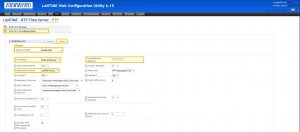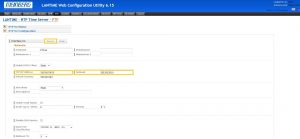By Andreja Jarc.
In my last post I promised to show you how to configure the IEEE 1588 Default Profile on a grandmaster (GM) via a web interface. This is what we will do right now.
We will use the same PTP master device M600/GPS/PTP from Meinberg with V6 firmware as we did in the last tutorial on the configuration over a front panel.
Check first the IP address of a LAN0 port on the device via a front panel. This can be reached by following these steps starting in the main menu: Network->Network Interfaces->lan0:0 IP Address. If it is not yet configured, do it additionally.
Open your web browser and type in the IP and login to a LANTIME Web Interface with given login credentials. As per default these are: root/timeserver.
Figure 1: A Login website to M600 in a web browser.
Proceed to the PTP Menu. Go to “PTP v2 Configuration” settings and select the Interface which will act as a Master port in your PTP network.
A little clarification here: if your device has only one PTP port it is no-brainer, but if it has more it needs to be defined at this point which will operate in the master mode.
Go to the PTPv2 Configuration menu-> Global settings and select the Default E2E profile. PTP Mode is set to Multicast Master and the Network Protocol UDP/IPv4 Layer 3 as defined in the IEEE 1588 v2 standard. The Announce (1 announce message every 2 sec), Sync (1 sync message per second) and Delay Request Interval (1 request every 8 seconds) set as per default leave for this example unchanged.
Figure 2: Configuration of the Default Profile via a Web interface.
Go to a Network settings tab in the Configuration menu. It is important that a valid IP Address and Netmask are assigned to the PTP port.
Figure 3: Network configuration of the PTP port.
An important note! Any modifications you do in the Web interface don’t forget to save (the “Save Settings” button can be found in the lower left corner of the page) and confirm with “Save as startup configuration now” to let it be available after the next reboot.
Now you are all set to try out the PTP synchronization with an end device (a slave clock). Please bear in mind that all settings between a master and the slave should coincide.
If you have any additional question or comment feel free to fill in the provided form below. I’ll be happy to assist you forward.



Hi Andreja,
how does the configuration look like with a P2P profile? Is there any difference in the config?
Thanks!
Regards,
TP
Hello TP,
P2P stands for Peer to Peer delay measurement between PTP nodes. The P2P mechanism works only where all switches are PTP capable and peer to peer capable. Then all delay measurement messages are exchanged only between adjacent devices across a link. The delay corrections are aggregated over switches that support P2P.
P2P itself is not a profile, it is the way the propagation delay is measured. But you are also right. P2P can be defined as a delay measurement method within a given profile, e.g. Utility Profile IEC 61850-9-3 uses P2P directly.
Some profiles e.g. SMPTE-ST 2059-2 use it as an option. Also in the Default IEEE 1588 Profile you can use P2P as an option. I hope this helps.
Hi
Which of these configuration parameters are applicable to Transparent clocks.
You mention L3 IP/UDP packets. Will these packets be routed at the network devices acting as transparent clocks or is routing of L3 packets only done by the network device implementing boundary clock. If you have an article about routing in PTP networks please share
Transparent clocks that are Ethernet switches can also correct L3 PTP messages in addition to routers. I have seen this work in PTP plugfests. Check with the switch manufacturer to see if you have to configure for L2 vs L3 PTP.
Hi Andreja,
I have Lantime m600 with 6.24.023.
I followed the steps listed in the block .. but “Port State” is stuck at “UNINITIALIZED”.
In”Main” tab, “Last messages” window, I am getting following messages.
—
2019-11-23 01:45:42 UTC: VP100/NET Display -> PTP Link Up [PTP Interface: 0 ]
2019-11-23 01:45:42 UTC: LANTIME -> PTP Link Up [PTP Interface: 0 ]
2019-11-23 01:45:37 UTC: VP100/NET Display -> PTP State Changed [PTP Interface: 0 (from stopped to UNINITIALIZED on PTP TSU0)]
—
Please advise.
Thanks
Joe
Hello Joe,
well, first of all a VP100 NET wall display is compliant with NTP but not with PTP protocol.
If the master state stays uninitialized, it may be that an IP address has not yet been assigned. Can this be the case?
To assign a proper IP, go to the PTP v2 Configuration Dialog and select the “Network” Tab. Check if you have a valid IP defined for your PTP card. If not, please do so.
If the problem still persists, there may be another misconfiguration issue. In that case, contact our Meinberg support.
Regards,
Andreja
I want to change root password of my box .
Could you please assist also i want to know what would be them impact if i change the default root password
You can and should change the root password of any network equipment after you receive it from the vendor. Just don’t lose the password.
Which segment do I need to set in the IP address?
I am connecting the M500 directly to a MUX, I need the PTP for teleprotection purposes…
So the port of the MUX does not have an IP, it does not need it but has a MAC Adress
If you are doing layer-3, unicast PTP, then obviously you will need to set up a IP address for your device. If you are doing layer-3 multicast, then the PTP messages will use the multicast IP addresses reserved for PTP. Most likely though, the device will require you to configure an IP address, before you can send and receive IP packets. You should configure all of your PTP devices to be in the same subnet, unless you have a router in your PTP network. If you are doing layer-2 PTP then perhaps you will not need to configure an IP address.